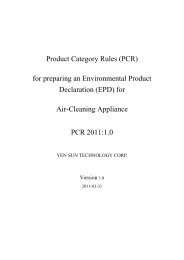Optoelectronic semiconductor - PCR Library
Optoelectronic semiconductor - PCR Library
Optoelectronic semiconductor - PCR Library
You also want an ePaper? Increase the reach of your titles
YUMPU automatically turns print PDFs into web optimized ePapers that Google loves.
Boundaries towards other technical systems<br />
Boundaries towards other technical systems describe the inputs of material and other<br />
components towards other systems, as well as outputs of materials towards other<br />
systems. For the inputs of recycled materials and energy towards the product<br />
manufacturing phase, the transportation between the recycling process and use of<br />
recycled materials shall be included in the data set. For the production of recyclable<br />
products during the manufacturing phase, the transportation towards the recycling<br />
process shall be included.<br />
(Note: Further explanations are provided in Section 7 on open-loop recycling)<br />
Boundaries regarding geographical coverage<br />
The manufacturing phase may cover manufacturing processes located on any sites<br />
around the world. For processes located in a specific region, the data used should be<br />
representative of the region. The data for the main components shall be the specific<br />
regional data for the region where the process takes place (see Section 9). For ease of<br />
comparison, no matter where the emissions are generated, the same parameters should<br />
be used for life cycle impact assessment (see Section 10).<br />
6. Cut-off rules<br />
For any impact category, if the sum of various impacts from a specific<br />
process/activity is less than 1% of the impact equivalent in that category, such a<br />
process/activity may be neglected during the inventory analysis. Components/parts<br />
and materials omitted from the LCA shall be documented.<br />
(Note: This judgment for this “1% Rule” is based on the environment relevance<br />
assessment of material input to the system, and does not consider special and<br />
exceptional environmental impacts.)<br />
7. Allocation rules<br />
The main allocation rules shall be valid for the entire product system. For other<br />
secondary processes, other allocation rules may be defined; however, the use of these<br />
rules should be justified. Product-specific information should be preferentially<br />
collected in order to avoid the need for allocation.<br />
While selecting allocation rules, the following principles are recommended.















